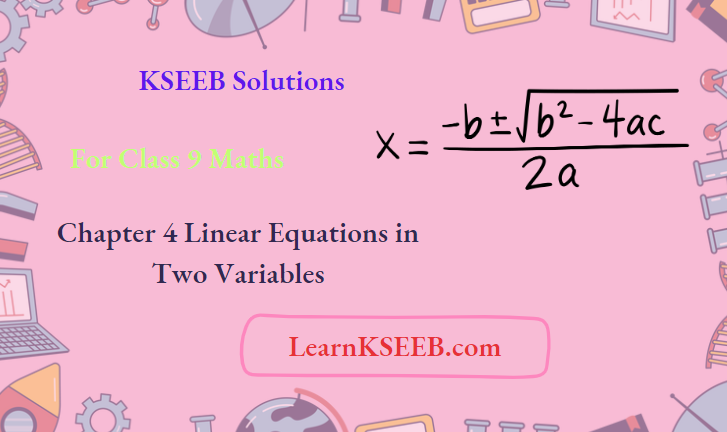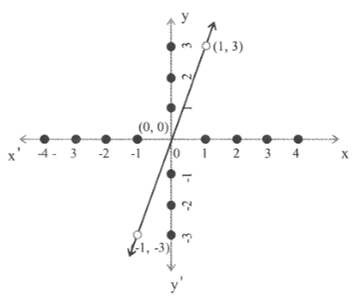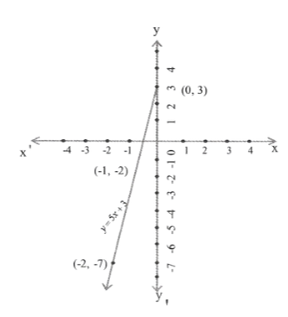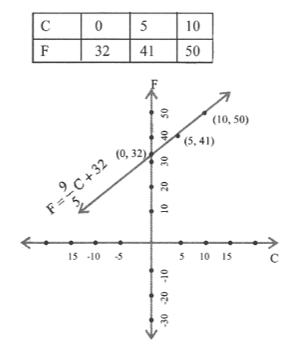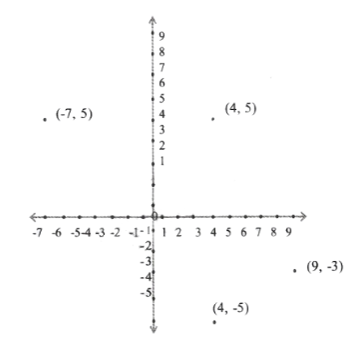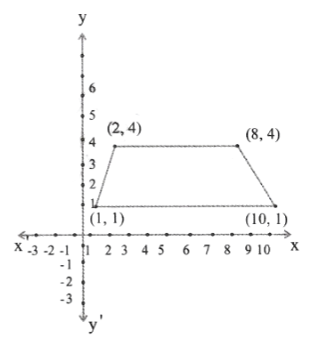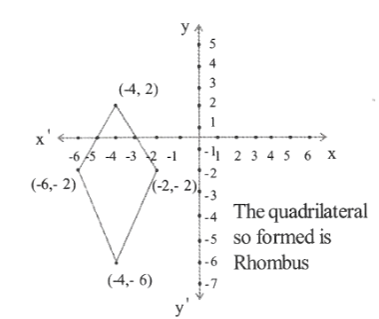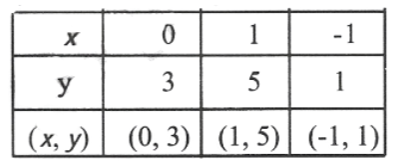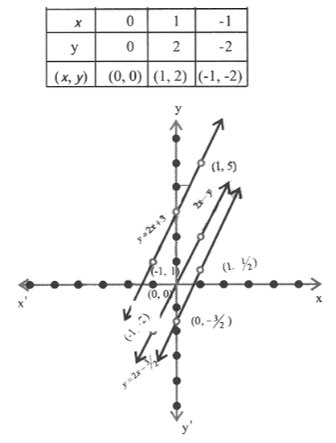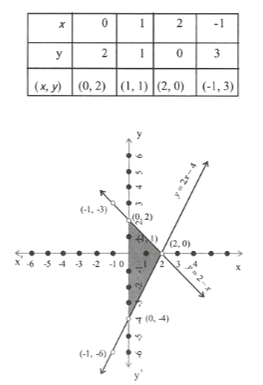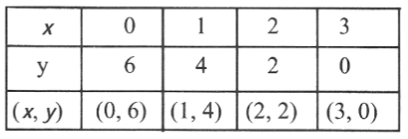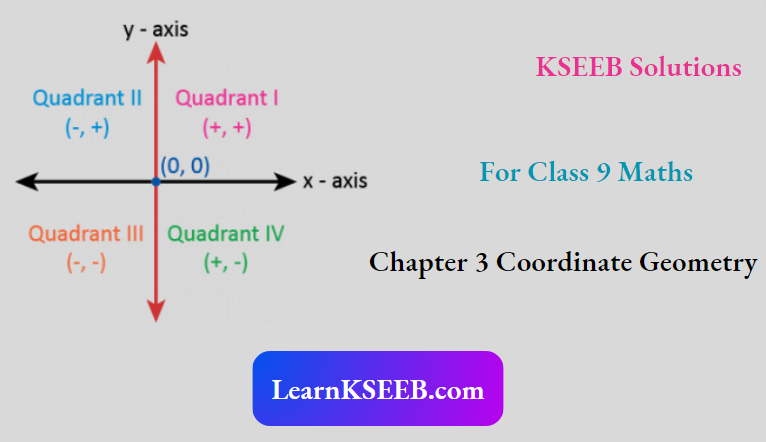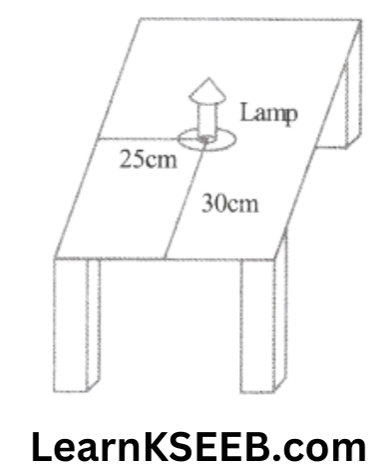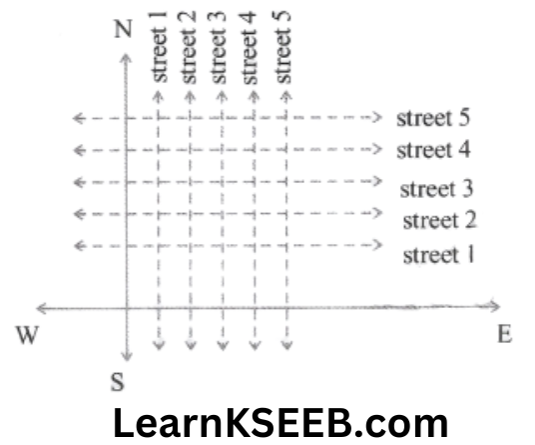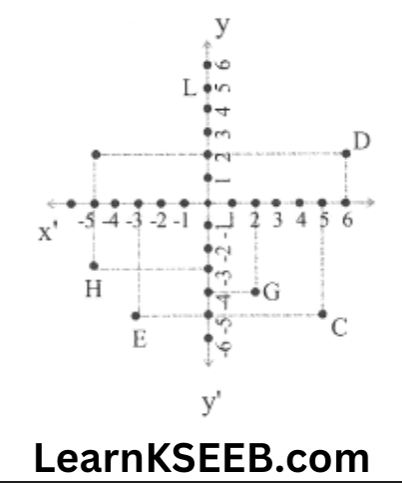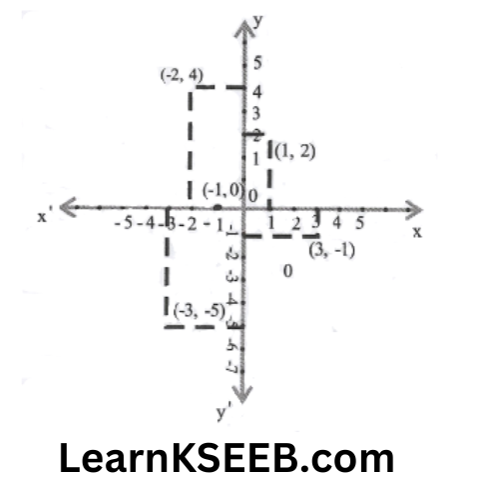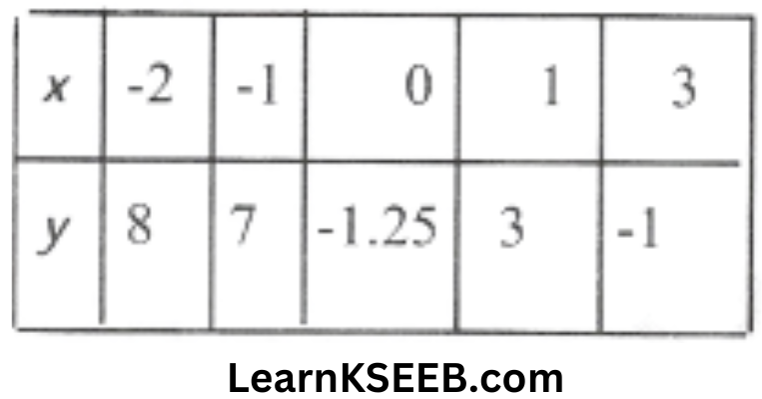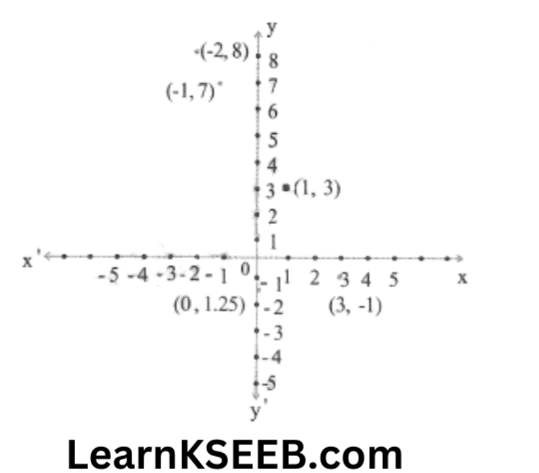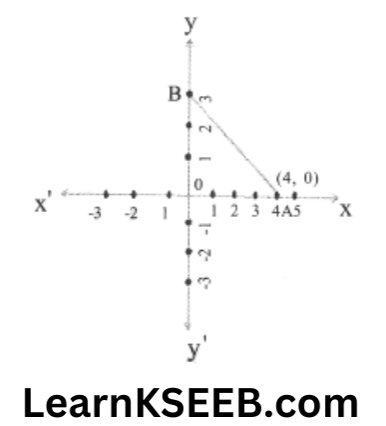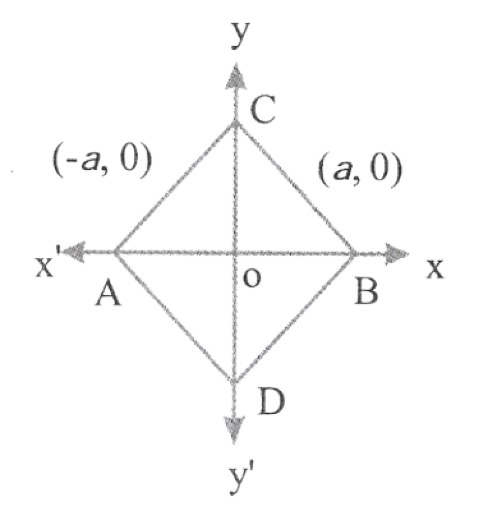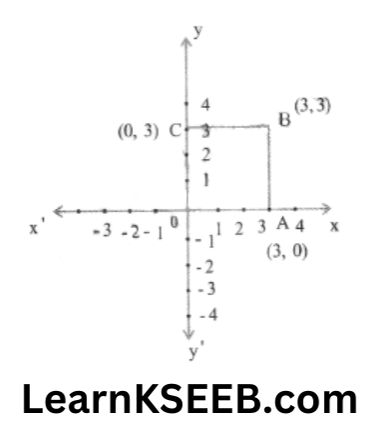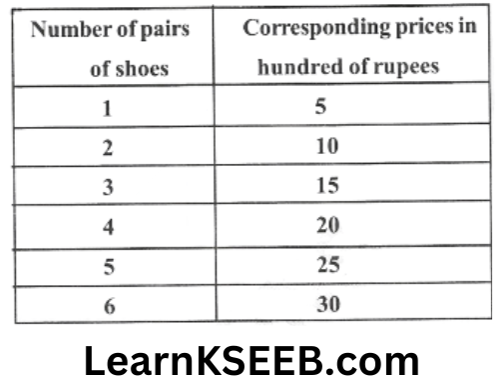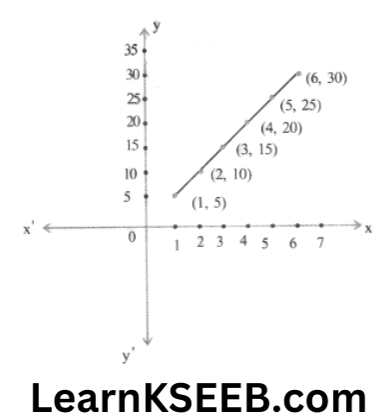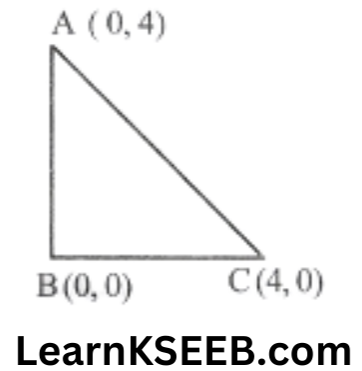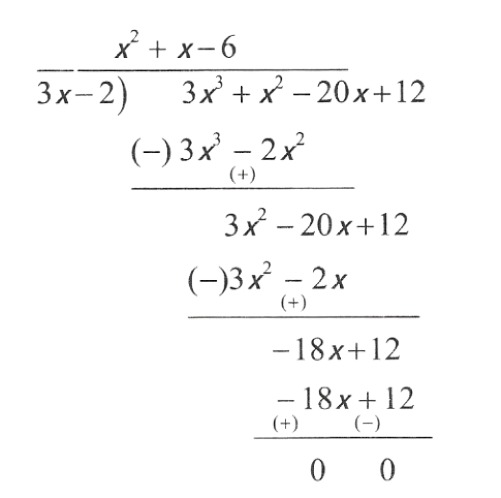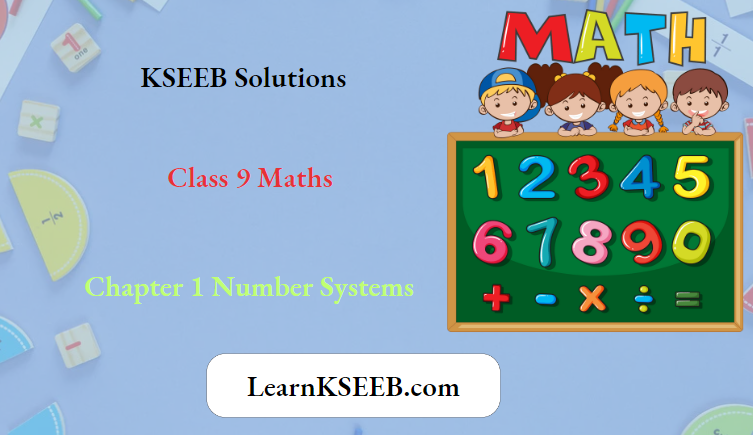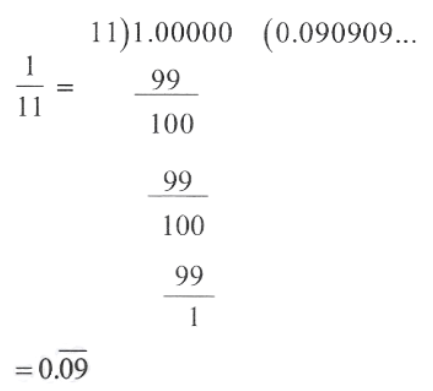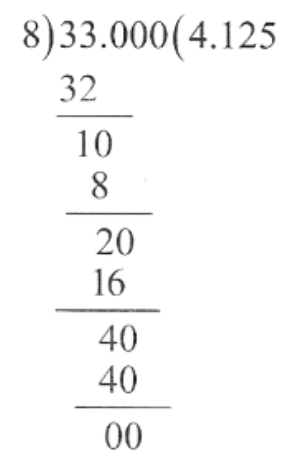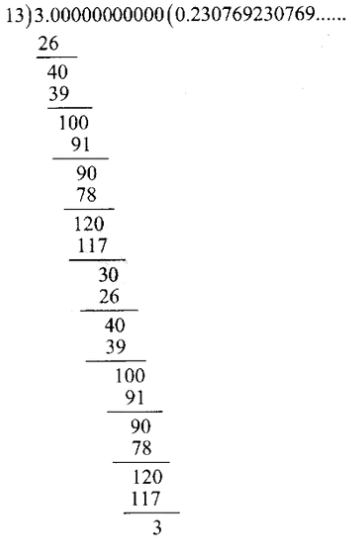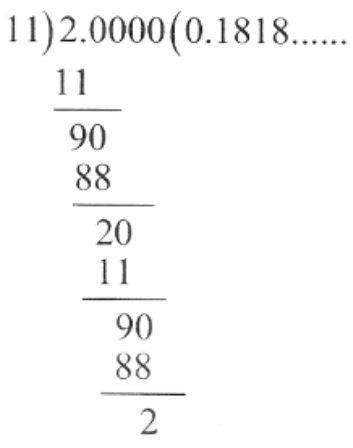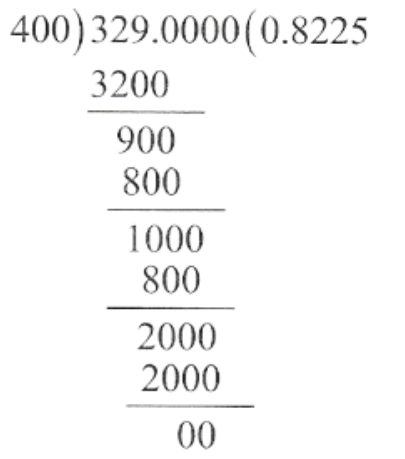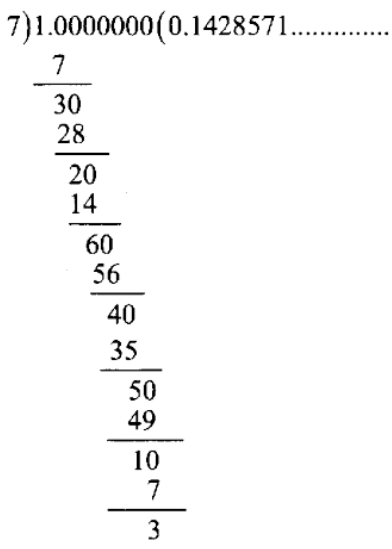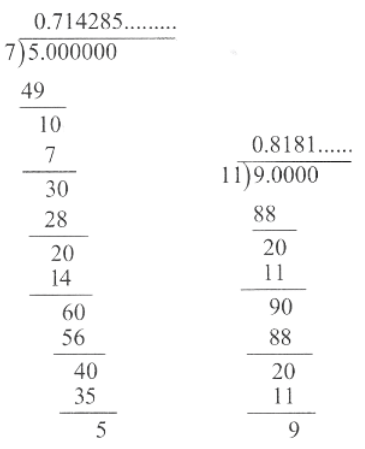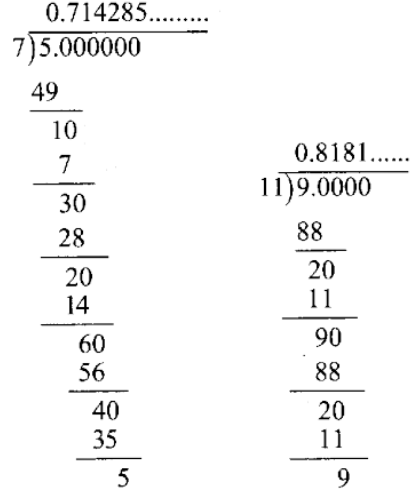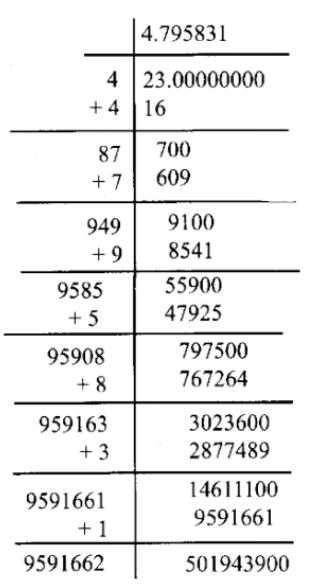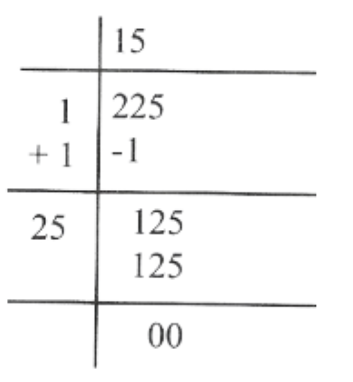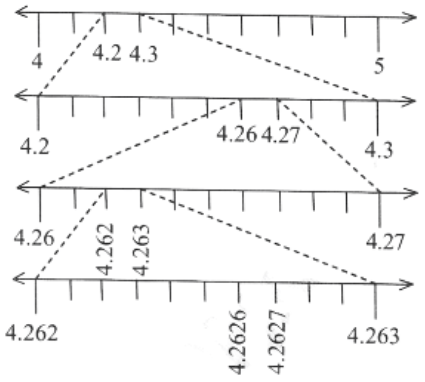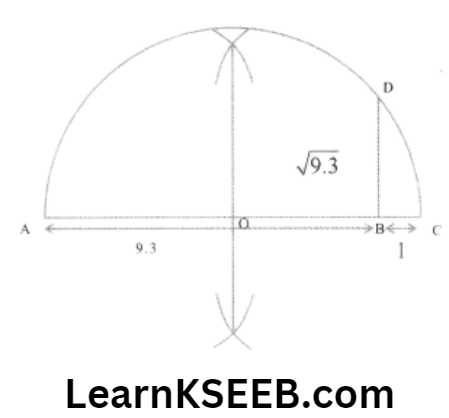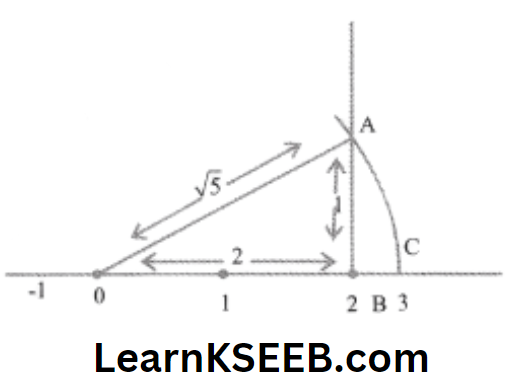KSEEB Solutions For Class 9 Maths Chapter 7 Triangles
Triangles Points to Remember
- A triangle is formed by three line segments obtained by joining three pairs of points taken from a set of three non-collinear points in a plane. A triangle has three vertices, three sides & three angles.
A triangle ABC is denoted by ΔABC

- Criteria for congruence of triangles.
Congruence of triangle.
The geometrical figures of same shape & size are congruent to each other i.e., two Δles ΔABC & ΔPQR are congruent if and only if their corresponding sides & the corresponding angles are equal.
| Class 9 Social Science | Class 9 Science | Class 9 Maths |
Read and Learn More KSEEB Solutions for Class 9 Maths

- If two triangles ΔABC & ΔPQR are congruent under the correspondence A → P, B → Q & C → R, then symbolically it is expressed as ΔABC ≅ ΔPQR
- SAS congruence Rule:
Two triangles are congruent if two sides & the included angle of one triangle are equal to the sides & the included angle of the other triangle. - ASA congruence Rule: Two triangles are congruent if two angles & the included side of one triangle are equal to two angles & the included side of the other triangle.
- AAS congruence Rule :
Two triangles are congruent if any two pairs of angles & one pair of corresponding sides are equal. - SSS congruence Rule:
If three sides of a triangle are equal to the three sides of another triangle, then the two triangles are congruent. - RHS congruence Rule:
If in two right triangles, the hypotenuse & one side of a triangle are equal to the hypotenuse & one side of the other triangle then the two triangles are congruent.
Note: It shall be noted that in SAS criteria the equality of included angles is very essential. If two sides & one angle (not included between the two sides) of one triangle are equal to two sides & one angle of the other triangle, then the triangles need not be congruent. So, the equal angle should be the angle included between the sides
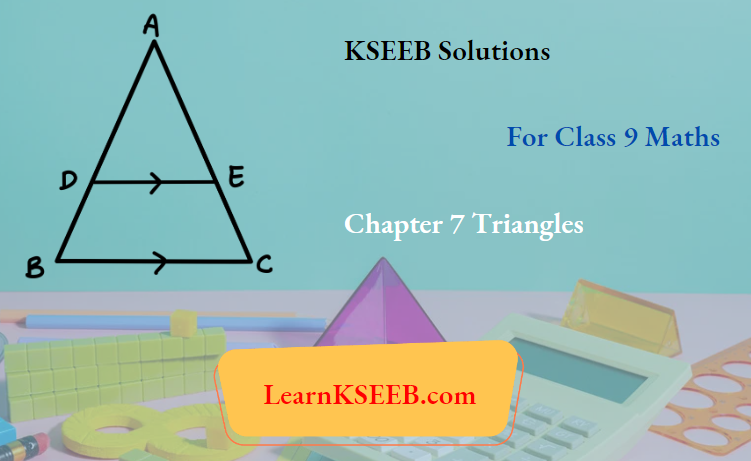
- Some properties of triangles.
A triangle is isosceles if any two sides are equal. Here, we prove some properties related to isosceles triangle.
(1) Angles opposite to equal sides of a triangle are equal.
In figure, \(\lfloor B\) = \(\lfloor C\)
2) The sides opposite to equal angles of a triangle are equal.
In figure, AB = AC

- In an isosceles triangle, bisector of the vertical angle of a triangle bisect the base.
- The medians of an equilateral triangle are equal in length.
- A point equidistance from two intersecting lines lies on the bisector of the angles formed by two lines.
Inequalities of a triangle - Angle opposite to the longer side is larger (greater)
- Side opposite to the larger (greater) angle is longer.
- Sum of any two sides is greater than the third side
i. e., in ΔABC, AB + BC > CA - Difference of any two sides of a triangle is less than
the third side i.e., in ΔABC, AB – BC <CA
KSEEB Class 9 Maths Chapter 7 Triangles Exercises
Triangles Exercise 7.1
1. In quadrilateral ACBD, AC =AD( & AB bisects \(\lfloor A\). Show that ΔABC ≅ ΔABD. What can you say about BC & BD?

Solution:
Given: In quadrilaterial ACBD, AC = BD & AB bisects \(\lfloor A\).
To prove : ΔABC ≅ ΔABD
Proof: In ΔABC & ΔABD
AC = AD (given)
AB =AB (common)
\(\lfloor\mathrm{CAB}\) = \(\lfloor\mathrm{DAB}\) (∵ AB bisects \(\lfloor A\))
∴ ΔABC ≅ ΔABD (SAS rule)
∴ BC = BD (C.P.C.T.)
2. ABCD is a quadrilateral in which AD = BC and [DAB = [CBA prove that
i) ΔABD ≅ ΔBAC
ii) BD =AC
iii) \(\lfloor\mathrm{ABD}\) = \(\lfloor\mathrm{BAC}\)
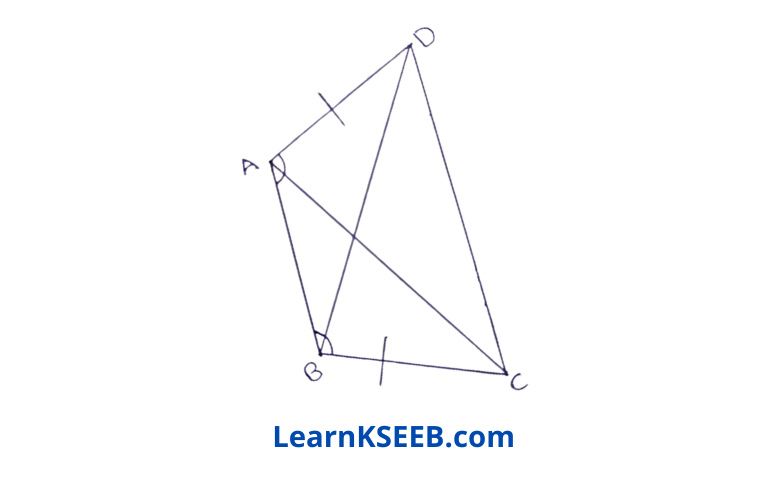
Solution:
Given : ABCD is a quadrilateral in which AD = BC & \(\lfloor\mathrm{DAB}\) = \(\lfloor\mathrm{CBA}\)
To prove:
1) ΔABD ≅ ΔBAC
2) BD = AC
3) \(\lfloor\mathrm{ABD}\) = \(\lfloor\mathrm{BAC}\)
Proof: 1) In ΔABD & ΔBAC
AD = BC (given)
AB = BA (common)
\(\lfloor\mathrm{DAB}\) = \(\lfloor\mathrm{CBA}\) (given)
∴ ΔABD ≅ ΔBAC (SAS rule)
2) ΔABD ≅ ΔBAC (proved in (1))
∴ BD = AC (CPCT)
3) ΔABD ≅ ΔBAC (proved in (1))
\(\lfloor\mathrm{ABD}\) = \(\lfloor\mathrm{BAC}\) (CPCT)
3. AD & BC are equal perpendicular to a line segment AB. Show that CD bisects AB.

Solution:
Given : AD & BC are equal perpendicular to a line segment AB.
To prove : CD bisects AB.
Proof: In ΔOAD & ΔOBC
AD = BC (given)
\(\lfloor\mathrm{OAD}\) = \(\lfloor\mathrm{OBC}\) (each = 90°)
\(\lfloor\mathrm{AOD}\) = \(\lfloor\mathrm{BOC}\) (vertically opposite angles)
∴ ΔOAD ≅ ΔOBC (AAS rule)
∴ OA = OB (CPCT)
∴ CD bisects AB.
KSEEB Maths Chapter 7 Triangles Answers
4. l and m are two parallel lines intersected by another pair of parallel lines p & q. Show that ΔABC ≅ ΔCDA.

Solution:
Given : l and m are two parallel lines interested by another pair of parallel lines p & q.
To prove : ΔABC ≅ ΔCDA
Proof: AB || DC
& AD || BC
Quadrilateral ABCD is a parallelogram.
(a quadrilateral ABCD is a parallelogram, if both the pairs of opposite sides are parallel)
∴ BC = AD …………….(1)
(opposite sides of a ||gm are equal)
∴ AB = CD ……………(2)
(opposite sides of a ||gm are equal)
& \(\lfloor\mathrm{ABC}\) = \(\lfloor\mathrm{CDA}\) ……………..(3)
(opposite angles of a ||gm are equal).
In ΔABC & ΔCDA
AB = CD from (2)
BC = DA from(1)
\(\lfloor\mathrm{ABC}\) = \(\lfloor\mathrm{CDA}\)from (3)
∴ ΔABC = ΔCDA (SAS rule)
5. Line l is the bisector of an angle\(\lfloor A\) & B is any point on l. BP & BQ are perpendicular from B to the arms of \(\lfloor A\). Show that 1) ΔAPB ≅ ΔAQB, 2) BP = BQ or B is equidistant from the arms of \(\lfloor A\).

Solution:
Given : Line l is the bisector of an angle A & B is any point on A BP & BQ are perpendicular from B to the arms of \(\lfloor A\).
To prove :
1) ΔAPB ≅ ΔAQB
2) BP = BQ
or
B is equidistance from the arms of \(\lfloor A\).
Proof: 1) In ΔAPB & ΔAQB,
\(\lfloor\mathrm{BAP}\) = \(\lfloor\mathrm{BAQ}\)(∵ l is the bisector of \(\lfloor A\))
AB = AB (common)
\(\lfloor\mathrm{BPA}\) =\(\lfloor\mathrm{BQA}\) =90°
(y BP & BQ are perpendiculars from B to the arms of \(\lfloor A\).)
∴ ΔAPB ≅ ΔAQB (AASrule)
2) ΔAPB ≅ ΔAQB (proved in (1) above)
∴ BP = BQ (CPCT)
6. In figure, AC = AE, AB = AD & \(\lfloor\mathrm{BAD}\) = \(\lfloor\mathrm{EAC}\). Show that BC =DE.

Solution:
Given : In figure, AC = AE, AB = AD & \(\lfloor\mathrm{BAD}\) = \(\lfloor\mathrm{EAC}\).
To prove: BC = DE
Proof: In ΔABC & ΔADE,
AB = AD (given)
AC = AE (given)
\(\lfloor\mathrm{BAD}\) = \(\lfloor\mathrm{EAC}\) (given)
=> \(\lfloor\mathrm{BAD}\) + \(\lfloor\mathrm{DAC}\) = \(\lfloor\mathrm{DAC}\)+ \(\lfloor\mathrm{EAC}\)
(adding \(\lfloor\mathrm{DAC}\) to both sides)
=>\(\lfloor\mathrm{BAC}\) = \(\lfloor\mathrm{DAE}\)
∴ ΔABC ≅ ΔADE (SAS rule)
∴ BC = DE (CPCT)
7. AB is a line segment & P is its mid-point D & E are points on the same side of AB such that
\(\lfloor\mathrm{BAD}\) = \(\lfloor\mathrm{ABE}\) & \(\lfloor\mathrm{EPA}\)=\(\lfloor\mathrm{DPB}\)
Show that i) ΔDAP ≅ ΔEBP 2) AD = BE

Solution:
Given: AB is a line segment & P is its mid-point D & E are points on the same side of AB such that
\(\lfloor\mathrm{BAD}\) = \(\lfloor\mathrm{ABE}\) & \(\lfloor\mathrm{EPA}\) = \(\lfloor\mathrm{DPB}\)
To prove : (1) ΔDAP = ΔEBP
(2) AD = BE
Proof: (1) In ΔDAP & ΔEBP
AP = BP (∵ P is the midpoint of the line segment AB)
\(\lfloor\mathrm{DAP}\) = \(\lfloor\mathrm{EBP}\) (given)
\(\lfloor\mathrm{EPA}\)=\(\lfloor\mathrm{DPB}\) (given)
=> \(\lfloor\mathrm{EPA}\) + \(\lfloor\mathrm{EPD}\)=\(\lfloor\mathrm{EPD}\) + \(\lfloor\mathrm{DPB}\)
(adding \(\lfloor\mathrm{EPD}\) to both sides)
=> \(\lfloor\mathrm{APD}\) –\(\lfloor\mathrm{BPE}\)
ΔDAP ≅ ΔEBP (ASA rule)
2) ΔDAP ≅ ΔEBP (from(1) above)
∴ AD = BE (CPCT)
KSEEB Solutions Class 9 Triangles Practice Problems
8. In right angle triangle ABC, right-angled at C, M is the midpoint of hypotenuse AB, C is joined to M & produced to a point D. Such that DM = CM. Point D is joined to point B show that
1) ΔAMC ≅ ΔBMD
2) \(\lfloor\mathrm{DBC}\) is a right-angled
3) ΔDBC ≅ ΔACB
4) CM = 1/2AB.

Solution:
Given: In right triangle ABC, right angled at C, M is the mid-point of hypotenuse AB. C is joined to M & produced to a point D. Such that DM = CM, Point D is joined to Point B.
To prove : 1) ΔAMC ≅ ΔBMD
2) \(\lfloor\mathrm{DBC}\) is a right angle
3) ADBC ≅ AACB
4) CM = 1/2AB
Proof: 1) In ΔAMC & ΔBMD
AM = BM (M is the midpoint of the hypotenuse AB)
CM = DM (given)
\(\lfloor\mathrm{AMC}\) = \(\lfloor\mathrm{BMD}\) (vertically opposite angle) (SAS rule)
∴ ΔAMC ≅ ΔBMD
2) ΔAMC ≅ ΔBMD (from(1) above)
∴\(\lfloor\mathrm{ACM}\) = \(\lfloor\mathrm{BDM}\) (CPCT)
but these are alternate interior angles and they are equal.
AC || BD
Now, AC || BD & a transversal BC intersects them
∴ \(\lfloor\mathrm{DBC}\)+\(\lfloor\mathrm{ACB}\) = 180°
(The sum of the consecutive interior angles on the same side of a transversal is 180°)
=> \(\lfloor\mathrm{DBC}\) + 90° = 180°
(∵ \(\lfloor\mathrm{ACB}\) = 90° given)
=> \(\lfloor\mathrm{DBC}\)-180 – 90 – 90°
=> \(\lfloor\mathrm{DBC}\) is a right angle.
3) In ΔDBC & ΔACB
\(\lfloor\mathrm{DBC}\) = \(\lfloor\mathrm{ACB}\)(each = 90°)
(proved in (2) above)
BC = CB (common)
ΔAMC ≅ ΔBMD (proved in (1) above)
∴ AC = BD (CPCT)
ΔDBC ≅ ΔACB (SAS rule)
4) ΔDBC ≅ ΔACD (proved in (3) above)
∴ DC = AB (CPCT)
=> 2CM = AB (∵ DM = CM = 1/2 DC)
=> CM = 1/2AB
Triangles Exercise 7.2
1. In an isosceles triangle ABC, with AB =AC, the bisectors of \(\lfloor b\) & \(\lfloor c\) intersect each other at O. Join A to O. Show that
1) OB = OC
2) AO bisects \(\lfloor A\)

Solution:
Given: In an isosceles triangle ABC, with AB =AC, the bisectors of \(\lfloor B\) & \(\lfloor C\) intersectAach other at O. Join A to O.
To prove : 1) OB = OC
2) AO bisects \(\lfloor A\)
Proof: 1) AB = AC (given)
\(\lfloor B\) = \(\lfloor C\) (Angles opposite to equal sides of a triangle are equal)
1/2\(\lfloor B\)=1/2\(\lfloor C\)
\(\lfloor\mathrm{OBC}\) = \(\lfloor\mathrm{OCB}\) (∵ BO & CO are the
bisectors of \(\lfloor B\) & \(\lfloor C\) respectively)
∴ OB = OC
(sides opposite to equal angles of triangles are equal)
2) In ΔOAB & ΔOAC
AB = AC (given)
OB = OC (proved in (1) above)
OA = OA (common)
\(\lfloor B\) = \(\lfloor C\)(Angles opposite to equal sides of a Δle are equal)
1/2\(\lfloor B\) = 1/2\(\lfloor C\)
∴ \(\lfloor\mathrm{ABO}\) = \(\lfloor\mathrm{ACO}\) (∵ BO & CO are the
bisectors of \(\lfloor B\) & \(\lfloor C\) respectively)
\(\lfloor\mathrm{OAB}\) = \(\lfloor\mathrm{OAC}\) (CPCT)
∴ AO bisects \(\lfloor C\)
Class 9 Maths KSEEB Chapter 7 Triangles Examples
2. In ΔABC,AD is the perpendicular bisector of BC. Show that ΔABC is an isosceles triangle in which AB= AC
Solution:
Given: In AABC, AD is the perpendicular bisector of BC.
To prove: AABC is an isosceles triangle in which AB = AC
Proof: In ΔADB & ΔADC
\(\lfloor\mathrm{ADB}\) = \(\lfloor\mathrm{ADC}\) = 90°
DB = DC (AD is the perpendicular bisector of BC)
AD=AD (common)
ΔADB ≅ ΔADC (by SAS rule)
∴ AB = AC (CPCT)
ΔABC is an isosceles triangle in which AB = AC.
3. ABC is an isosceles triangle in which altitudes BE & CF are drawn to sides AC & AB respectively. Show that these altitudes are equal.
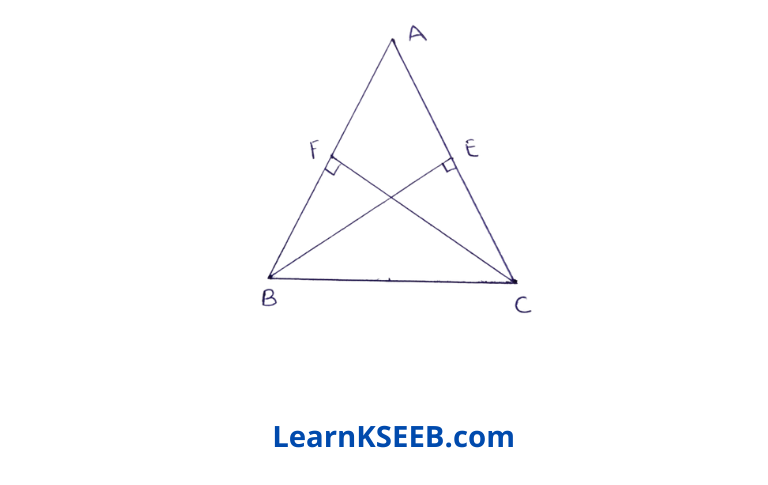
Solution:
Given: ABC is an isosceles triangle in which altitudes BE & CF are drawn to sides AC & AB respectively.
To prove : BE = CF
Proof: ABC is an isosceles triangle
∴ AB = AC
& \(\lfloor\mathrm{ABC}\) = \(\lfloor\mathrm{ACB}\) (angles opposite to …………(1) equal sides of a Δle are equal)
In ΔBEC&ΔCFB \(\lfloor\mathrm{BEC}\) = \(\lfloor\mathrm{CFB}\) = 90°
BC = CB (common)
\(\lfloor\mathrm{ECB}\) = \(\lfloor\mathrm{FBC}\) (from(1))
∴ ΔBEC & ΔCFB (by AAS rule)
∴ BE = CF (CPCT)
4. ABC is a Δle in which altitudes BE & CF to sides AC & AB are equal Show that

1) ΔABE ≅ ΔACF
2) AB=AC ie, ΔABC is an isosceles Δle
Solution:
Given : ABC is a Δe in which altitudes BE & CF to sides AC & AB are equal
To prove : 1) ΔABE ≅ ΔACF
2) AB = AC i.e. ABC is an isosceles Δle.
Proof: 1) In ΔABE & ΔACF
BE = CF (Given)
\(\lfloor\mathrm{ABE}\) = \(\lfloor\mathrm{CAF}\) (common)
\(\lfloor\mathrm{AEB}\)= \(\lfloor\mathrm{AFC}\) = 90°
ΔABE = ΔACF (byAAS rule)
2) ΔABE = ΔACF (proved in (1) above)
AB = AC (C.P.C.T.)
ΔABC is an isosceles Δle.
5. ABC & DBC are two isosceles Δle on the same base BC (see figure) show that \(\lfloor\mathrm{ABD}\) = \(\lfloor\mathrm{ACD}\)

Solution:
Given : ABC & DBC are two isosceles Δle on the same base BC.
To prove : \(\lfloor\mathrm{ABD}\) = \(\lfloor\mathrm{ACD}\)
Proof: ABC is an isoscles Δle on the base BC.
∴ \(\lfloor\mathrm{ABC}\) = \(\lfloor\mathrm{ACB}\) …………..(1)
DBC is an isosceles Δle on the base BC.
\(\lfloor\mathrm{DBC}\) – \(\lfloor\mathrm{DCB}\) ……………..(2)
adding the corresponding sides of (1) & (2) we get
\(\lfloor\mathrm{ABC}\) + \(\lfloor\mathrm{DBC}\)= \(\lfloor\mathrm{ACB}\)+ \(\lfloor\mathrm{DCB}\)
=> \(\lfloor\mathrm{ABD}\) = \(\lfloor\mathrm{ACD}\)
Hence proved.
6. ΔABC is an isosceles Δle triangle in which AB = AC. side BA is produced to D such that AD = AB (see fig). Show that \(\lfloor\mathrm{BCD}\) is a right angle.

Solution:
Given : ΔABC is an isosceles Δle in which AB = AC. side BA is produced to D such that AD =AB.
To prove: \(\lfloor\mathrm{BCD}\)is a right angle.
Proof: ABC is an isosceles Δle
∴\(\lfloor\mathrm{ABC}\) = \(\lfloor\mathrm{ACB}\) ………………(1)
AB = AC &
AD =AB
=> AC = AD In ΔACD
\(\lfloor\mathrm{CDA}\) = \(\lfloor\mathrm{ACD}\) (angles opposite to equal sides of a Δle are equal).
\(\lfloor\mathrm{CDB}\) – \(\lfloor\mathrm{ACD}\) …………..(2)
adding the corresponding sides of (1) & (2) we get.
\(\lfloor\mathrm{ABC}\) + \(\lfloor\mathrm{CDB}\) = \(\lfloor\mathrm{ACB}\) + \(\lfloor\mathrm{ACD}\)
=> \(\lfloor\mathrm{ABC}\)+\(\lfloor\mathrm{CDB}\) = \(\lfloor\mathrm{BCD}\) ……………….(3)
In ΔBCD
\(\lfloor\mathrm{BCD}\) + \(\lfloor\mathrm{DBC}\)+ \(\lfloor\mathrm{CDB}\) = 180° (sum of all the angles of a is 180°)
=> \(\lfloor\mathrm{BCD}\) + \(\lfloor\mathrm{ABC}\) + \(\lfloor\mathrm{CDB}\) = 180°
=> \(\lfloor\mathrm{BCD}\)+ \(\lfloor\mathrm{BCD}\) =180° (using(3))
=> 2\(\lfloor\mathrm{BCD}\) =180°
=> \(\lfloor\mathrm{BCD}\) =180°/2= 90°
=> \(\lfloor\mathrm{BCD}\) is a right angle.
KSEEB Chapter 7 Triangles Solved Questions
7. ABC is a right angled Δle in which \(\lfloor A\) = 90° & AB =AC. Find \(\lfloor B\) & \(\lfloor C\).
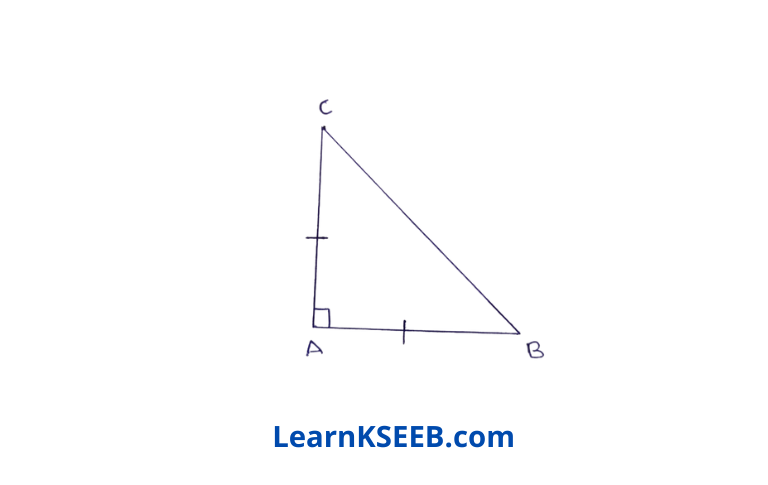
Solution: In ΔABC
AB = AC
∴ \(\lfloor B\) = \(\lfloor C\) (angles opposite to equal sides of a Δle are equal)……………..(1)
In ΔABC
\(\lfloor A\)+\(\lfloor B\)+ \(\lfloor C\) = 180° (angle sum property)
=> 90° +\(\lfloor B\) + \(\lfloor C\) = 180° (∵ \(\lfloor A\)= 90° given)
=> \(\lfloor B\)+ \(\lfloor C\) = 180°- 90° = 90° ……………..(2)
from (1) & (2) we get.
\(\lfloor B\) = \(\lfloor C\) = 45°
8. Show that the angles of an equilateral Δle are 60° each.
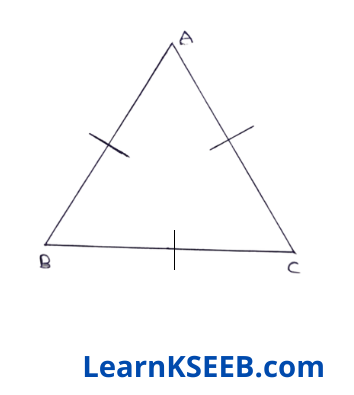
Solution:
Given : An equilateral Δle ABC.
To prove : \(\lfloor A\) = \(\lfloor B\)= \(\lfloor C\)= 60°
Proof: ABC is an equilateral Ale.
∴ AB = AC = CA ……………..(1)
AB = BC
=> \(\lfloor A\) = \(\lfloor C\) (Angles opposite to equal sides of a triangle are equal) …………….(2)
BC = CA
=> \(\lfloor A\) = \(\lfloor B\) (Angles opposite to equal sides ……………(3) of a triangle are equal)
from (2) & (3) we get
\(\lfloor A\) = \(\lfloor B\) = \(\lfloor C\) …………………(4)
In ΔABC
\(\lfloor A\)+\(\lfloor B\) + \(\lfloor C\) = 180° (angle sum property)
=> \(\lfloor A\)=\(\lfloor B\) = \(\lfloor C\) = 60°
Triangles Exercise 7.3
1. ΔABC & ΔDbC are two isosceles triangles on the same base BC & vertices A & D are on the same side of BC (see figure). If AD is extended to intersect BC at P. Show that
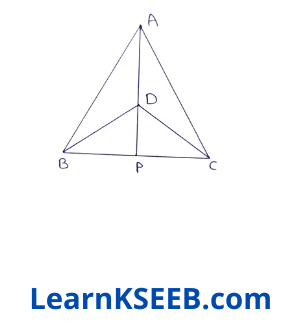
1) ΔABD ≅ ΔACD
2) ΔABP ≅ ΔACP
3) AP bisects \(\lfloor A\) as well as \(\lfloor D\)
4) AP is the perpendicular bisector of BC
Solution:
Given: ΔABC & ΔDBC are two isosceles Δle s on the same base BC & vertices A & D are on the same side of BC. AD is extended to intersect BC at P.
To prove : 1) ΔABD ≅ ΔACD
2) ΔABP ≅ ΔACP
3) AP bisects \(\lfloor A\) as well as \(\lfloor D\)
4) AP is the perpendicular bisector of BC.
Proof: (1) In ΔABD & ΔACD
AB =AC ……….(1) (AABC is an isosceles A/e)
BD = CD …………(2)( ADBC is an isosceles A/e)
AD = AD …………..(3) (common)
ΔABD ≅ ΔACD (SSSrule)
2) In ΔABP & ΔACP
AB=AC ………………(4) (from 1)
\(\lfloor\mathrm{ABP}\) = \(\lfloor\mathrm{ACP}\) ……………(5)
{(∵ AB = AC from (1)
∴\(\lfloor\mathrm{ABP}\) = \(\lfloor\mathrm{ACP}\) angles opposite to equal sides of a Δle are equal)}
∴ ΔABD ≅ ΔACD (proved in (1) above)
∴ \(\lfloor\mathrm{BAP}\) – \(\lfloor\mathrm{CAP}\) …………….(6) (CPCT)
In view (4), (5) & (6)
ΔABP ≅ ΔACP (ASA rule)
(3) ∵ ΔABP ≅ ΔACP (proved in (2) above)
=> AP bisects \(\lfloor A\)
In \(\lfloor\mathrm{BDP}\) & \(\lfloor\mathrm{CDP}\)
BD = CD ………….(7) (from (2))
DP = DP ………….(8) (common)
∴ ΔABP ≅ ΔACP (proved in (2) above)
BP = CP …………..(9) (CPCT)
In view of (7), (8) (9)
ΔBDP ≅ ΔCDP (SSS Rule)
\(\lfloor\mathrm{BDP}\) = \(\lfloor\mathrm{CDP}\) (CPCT)
=> DP bisects \(\lfloor D\)
=> AP bisects \(\lfloor D\)
(4) ∵ ΔBDP ≅ ΔCDP (proved in (3) above)
∴ BP = CP ……………(10) (CPCT)
\(\lfloor\mathrm{BPD}\) = \(\lfloor\mathrm{CPD}\) (CPCT)
but \(\lfloor\mathrm{BPD}\) + \(\lfloor\mathrm{CPD}\)= 180° ……………….(11)
linear pair
In view of (10 & (11)
AP is the perpendicular bisector of BC.
2. AD is an altitude of an isosceles A triangle ABC in which AB = AC.
Show that
1) AD bisects BC
2) AD bisects \(\lfloor A\)

Solution:
Given : AD is an altitude of an isosceles Δle ABC in which AB = AC
To prove : 1) AD bisects BC
2) AD bisects \(\lfloor A\)
Proof: 1) In right ΔADB & right ΔADC
Hyp AB = Hyp. AC (Given)
side AD = side AD (common)
\(\lfloor\mathrm{ADB}\) = \(\lfloor\mathrm{ADC}\)= 90°
ΔADB ≅ ΔADC (RHS rule)
BD = CD (C.P.C.T.)
=> AD bisects BC
ii) ΔADB ≅ ΔADC (proved in (1) above)
\(\lfloor\mathrm{BAD}\) = \(\lfloor\mathrm{CAD}\) (C.P.C.T.)
=> AD bisects \(\lfloor A\)
3. Two sides AB & BC & median AM of one triangle ABC are respectively equal to sides PQ & QR & median PN of triangle PQR (see figure). Show that
1) ΔABM ≅ ΔPQN
2) ΔABC ≅ ΔPQR

Solution:
Given : Two sides AB & BC & median AM of one triangle ABC are respectively equal to sides PQ & QR & median PN of ΔPQR
To prove : 1) ΔABM ≅ ΔPQN
2) ΔABC ≅ ΔPQR
Proof: 1) In ΔABM & ΔPQN
AB = PQ ……………(1) (given)
AM = PN …………….(2) (given)
BC = QR
=> 2BM = 2QN (M & N are the mid-points of BC & QR respectively)
=> BM = QN …………….(3)
In view of(l), (2) & (3)
2) ΔABM = ΔPQN (proved in (1) above)
\(\lfloor\mathrm{ABM}\) = \(\lfloor\mathrm{PQN}\) (C.P.C.T.)
=> \(\lfloor\mathrm{ABC}\) = \(\lfloor\mathrm{PQR}\) (4)
In ΔABC & ΔPQR
AB = PQ (given)
BC = QR (given)
\(\lfloor\mathrm{ABC}\) = \(\lfloor\mathrm{PQR}\) (from (4))
∴ ΔABC = ΔPQR (by SAS rule)
KSEEB Solutions for 9th Standard Maths Chapter 7 Triangles
4. BE & CF are two equal altitudes of a ΔABC using RHS congruence rule, prove that the triangle ABC is isosceles.

Solution:
Given : BE & CF are two equal A altitudes of a ΔABC
To prove : ABC is isosceles. F E
Proof: In right ΔBEC & right
ΔCFB
side BE = side CF (given)
Hyp. BC = Hyp. CB (common)
ΔBEC = ΔCFB (RHS rule)
\(\lfloor\mathrm{BCE}\) = \(\lfloor\mathrm{CBF}\) (C.P.C.T)
AB = AC (sides opposite to equal angles of a Δle are equal)
∴ ΔABC is isosceles.
5. ABC is an isosceles A/e with AB = AC. Draw AP⊥BC show that \(\lfloor B\) = \(\lfloor C\)

Solution:
Given: ABC is an isosceles A/e with AB=AC
To prove : \(\lfloor B\)= \(\lfloor C\)
Construction : Draw AP ⊥ BC
Proof: In right triangle APB & right triangle APC.
Hyp. AB = Hyp. AC (given)
side AP = side AP (common)
∴ ΔAPB ≅ ΔAPC (RHS rule)
\(\lfloor\mathrm{ABP}\) = \(\lfloor\mathrm{ACP}\) (C.P.C.T.)
=> \(\lfloor B\)= \(\lfloor C\)
Triangles Exercise 7.4
1. Show that in a right-angled triangle, the hypotenuse is the longest side.

Solution: Let ABC be a right-angled triangle in which \(\lfloor B\) = 90°
then \(\lfloor A\) + \(\lfloor C\) = 90° (sum of all the angles of a Δle is 180°)
∴ \(\lfloor B\) = \(\lfloor A\) + \(\lfloor C\)
∴ \(\lfloor B\)>\(\lfloor A\) & \(\lfloor B\)>\(\lfloor C\)
∴ AC>BC (∴ side opposite to greater angle is longer)
& AC > AB
∴ AC is the longest side, i.e., the hypotenuse is the longest side.
2. In figure sides AB & AC of AABC are extended to points P & Q respectively. Also \(\lfloor\mathrm{PBC}\) < \(\lfloor\mathrm{QCB}\), Show that AC > AB.

Solution:
Given: sides AB &AC are extended to points P & Q respectively. Also,\(\lfloor\mathrm{PBC}\)< \(\lfloor\mathrm{QCB}\)
To prove : AC > AB
Proof: \(\lfloor\mathrm{PBC}\) < \(\lfloor\mathrm{QCB}\) (given)
=> –\(\lfloor\mathrm{PBC}\) > –\(\lfloor\mathrm{QCB}\)
=> 180 – \(\lfloor\mathrm{PBC}\) > 180°-\(\lfloor\mathrm{QCB}\)
∴ \(\lfloor\mathrm{ABC}\)>\(\lfloor\mathrm{ACB}\)
∴ AC > AB
∴ sides opposite to greater angle is longer.
3. In figure, \(\lfloor B\) < \(\lfloor A\)& \(\lfloor C\) < \(\lfloor D\) show that AD < BC.
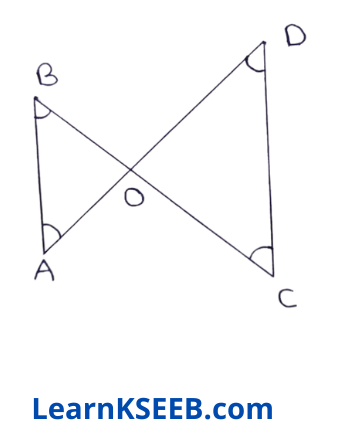
Solution:
Given : In figure, \(\lfloor B\) < \(\lfloor A\) & \(\lfloor C\) < \(\lfloor D\)
To prove :
AD < BC
Proof: \(\lfloor B\)< \(\lfloor A\)(given)
\(\lfloor A\)>\(\lfloor B\)
OB >OA …………….(1)
(side opposite to greater angle is longer)
\(\lfloor C\) < \(\lfloor D\) (given)
∴ \(\lfloor D\) > \(\lfloor C\)
∴ OC>OD ……………..(2)
(side opposite to greater angle is longer)
from (1) & (2), we get
OB + OOOA + OD
=>BC > AD
=> AD < BC
4. AB & CD are respectively the smallest & longest sides of a quadrilateral ABCD (see figure).
Show that \(\lfloor A\) > \(\lfloor C\) & \(\lfloor B\) > \(\lfloor D\)

Solution:
Given: AB & CD are respectively the smallest and longest sides of a quadrilateral ABCD.
To prove : \(\lfloor A\) > \(\lfloor C\) & \(\lfloor B\) > \(\lfloor D\)
Construction: Join AC
Proof: In ΔABC AB < BC (∵ AB is the smallest side of quadrilateral ABCD)
=> BC > AB
\(\lfloor\mathrm{BAC}\)> \(\lfloor\mathrm{BCA}\) (angle opposite to longer ……………(1)side is greater)
In ΔACD
CD > AD (∵ CD is the longest side of quadrilateral ABCD)
∴ \(\lfloor\mathrm{CAD}\) > \(\lfloor\mathrm{ACD}\) (angle opposite to longer side is greater) from(l) & (2), we obtain
\(\lfloor\mathrm{BAC}\) + \(\lfloor\mathrm{CAD}\) > \(\lfloor\mathrm{BCA}\)+ \(\lfloor\mathrm{ACD}\)
\(\lfloor A\)>\(\lfloor C\)
||ly joining B to D, we can prove that \(\lfloor B\) > \(\lfloor D\)
5. In figure, PR > PQ & PS bisects \(\lfloor\mathrm{QPR}\). Prove that \(\lfloor\mathrm{PSR}\) > \(\lfloor\mathrm{PSQ}\)

Solution:
Given: In figure, PR > PQ & PS bisects \(\lfloor\mathrm{QPR}\)
To prove : \(\lfloor\mathrm{PSR}\) > \(\lfloor\mathrm{PSQ}\)
Proof: In ΔPQR
PR>PQ (given)
∴ \(\lfloor\mathrm{PQR}\) > \(\lfloor\mathrm{PRQ}\) ………………..(1) (angle opposite to the longer side is greater)
PS bisects \(\lfloor\mathrm{QPR}\)
∴ \(\lfloor\mathrm{QPS}\) = \(\lfloor\mathrm{RPS}\) ……………….(2)
In ΔPQS
\(\lfloor\mathrm{PQR}\) + \(\lfloor\mathrm{QPS}\) + \(\lfloor\mathrm{PSQ}\) = 180° ………………..(3)
(angle sum property of a Δle)
In ΔPRS
\(\lfloor\mathrm{PRS}\)+\(\lfloor\mathrm{SPR}\) + \(\lfloor\mathrm{PSR}\) = 180° ……………….(4)
(Angle sum property of a Δle) from (3) & (4) we get
\(\lfloor\mathrm{PQR}\) + \(\lfloor\mathrm{QPS}\)+ \(\lfloor\mathrm{PSQ}\) = \(\lfloor\mathrm{PRS}\) + \(\lfloor\mathrm{SPR}\)+
\(\lfloor\mathrm{PSR}\)=> \(\lfloor\mathrm{PQR}\) + \(\lfloor\mathrm{PSQ}\) = \(\lfloor\mathrm{PRS}\) + \(\lfloor\mathrm{PSR}\)
(∵ \(\lfloor\mathrm{QPS}\) = \(\lfloor\mathrm{SPR}\))
=> \(\lfloor\mathrm{PRS}\) + \(\lfloor\mathrm{PSR}\) = \(\lfloor\mathrm{PQR}\)+ \(\lfloor\mathrm{PSQ}\)
=> \(\lfloor\mathrm{PRS}\) + \(\lfloor\mathrm{PSR}\) > \(\lfloor\mathrm{PRQ}\)+ \(\lfloor\mathrm{PSQ}\)(from(1))
=> \(\lfloor\mathrm{PRQ}\) + \(\lfloor\mathrm{PSR}\) > \(\lfloor\mathrm{PSR}\)+ \(\lfloor\mathrm{PSQ}\)
(∵ \(\lfloor\mathrm{PSQ}\) = \(\lfloor\mathrm{PSR}\))
=> \(\lfloor\mathrm{PSR}\) > \(\lfloor\mathrm{PSQ}\)
6. Show that of all line segments drawn from a given point not on it, the perpendicular line segment is the shortest.
Solution: Let l is a line & P is a point not lying on l , PM ⊥ l N is any point on l other than M.
To prove : PM < PN

Proof: In ΔPMN
\(\lfloor M\) = 90°
∴ \(\lfloor N\) is an acute angle
(angle sum property of a Δle)
\(\lfloor M\) >\(\lfloor N\)
PN > PM (side opposite to greater angle is greater)
=> PM < PN
Additional Problems
Choose the correct answer from the following:
1. In ΔABC = ΔACB then ΔABC is isosceles with

- AB = AC A
- AB = BC
- AC = BC
- None of these
Solution: 1. AB = AC
2. Which of the following is not a criterion for congruence of triangles?

- SAS
- SSA
- ASA
- SSS
Solution: 2. SSA
KSEEB Maths Chapter 7 Triangles Free Solutions
3. In triangle ABC & PQR, if \(\lfloor A\) = \(\lfloor R\) ,\(\lfloor B\)= \(\lfloor P\) & AB = RP, then which one of the following congruence conditions applies.
- SAS
- ASA
- SSS
- RHS
Solution: 2. ASA
4. In the following figure, write the relation between AB & AC.
- AB > AC
- AB < AC
- AB = AC
- AB = 1/2 AC
Solution: 1. AB > AC
5. In the following figure, in ΔABC, AB = AC, CD = CA & \(\lfloor\mathrm{ADC}\) = 20°, then \(\lfloor\mathrm{ABC}\) =
- 10°
- 20°
- 30°
- 40°
Solution: 4. 40°
6. In ΔABC, \(\lfloor C\) = \(\lfloor A\) & BC = 6cm & AC = 5cm then the length of AB is
- 6cm
- 5cm
- 3cm
- 2.5cm
Solution: 1. 6cm
7. ΔABC ≅ ΔPQR, then which of the following is true
- A↔R
- AB = QR
- AC = PQ
- AB = PQ
Solution: 4. AB = PQ
8. Two sides of a triangle are of length 7cm & 3.5 cm. The length of the third side of the triangle cannot be
- 3.6cm
- 4.1cm
- 3.4cm
- 3.8cm
Solution: 3. 3.4cm
9. In given figure, if AE || DC & AB = AC, the value of \(\lfloor\mathrm{ABD}\) is

- 70°
- 110°
- 120°
- 130°
Solution: 2. 110°
10. In given figure, the measure of \(\lfloor\mathrm{PQR}\) is _

- 50°
- 60°
- 70
- 80°
Solution: 2. 60°
11. In ΔABC AB = AC, BD = EC, then ΔADE is

- right-angled
- Scalene
- Isosceles
- equilateral
Solution: 3. Isosceles
One Mark Questions
1. In ΔABC & ΔDEF, AB = DE, \(\lfloor A\) = \(\lfloor D\) What will be the condition in which the two triangles will be congruent by SAS axiom?
Solution: Since AB = DE
\(\lfloor A\) = \(\lfloor D\)
& ΔABC ≅ ΔDEF

by SAS
∴ AC = DF
2. What do we call a triangle if the angles are in the ratio 5:3:7?
Solution: Let the angles of triangles are 5x, 3x& 7x, then
5x+3x + 7x=180°
15x= 180
x = 180/15=12°
∴ Angles are 60°, 36°, 84°
∴ Each angle is less than 90°
The Δle is an acute-angled triangle.
3. In the figure below, if AB = AC, then what is the value of x?
Solution: \(\lfloor\mathrm{ABC}\) = 180- 125 = 55°
AB = AC,

=> \(\lfloor\mathrm{ACB}\) = \(\lfloor\mathrm{ABC}\) = 55°
=> x = 180-55-55°
=> x=70°
4. Is it possible to construct a triangle, when its sides are 5.4cm, 2.3cm, 3.1cm?
Solution: No, Because 2.3 + 3.1 = 5.4cm
Not possible to construct a Δle.
5. From the given figure A show that AB > BD

Solution: If D is a point on the side BC of a ΔABC such that
AD bisects \(\lfloor\mathrm{BAC}\) then AB > BD
6. In ΔABC \(\lfloor B\) = 30°, \(\lfloor C\) = 80°&\(\lfloor A\) = 70° then prove that AB > BC > AC
Solution:

Since \(\lfloor C\) > \(\lfloor A\) > \(\lfloor B\)
∴ AB > BC > AC
7. ΔABC is an isosceles right-angled triangle in which \(\lfloor A\) =90°. Calculate \(\lfloor B\).
Solution: AB=AC \(\lfloor B\) = \(\lfloor C\)
By angle sum property.

\(\lfloor A\) + \(\lfloor B\) + \(\lfloor C\) = 180°
=> 90° + \(\lfloor B\) + \(\lfloor B\) = 180°
2\(\lfloor B\) = 90°
\(\lfloor B\) = 9%/2 = 45°
8. In ΔPQR PE is the perpendicular bisector of \(\lfloor\mathrm{QPR}\) , then prove that PQ = PR
Solution: In ΔPEQ & ΔPER
\(\lfloor\mathrm{PEQ}\) = \(\lfloor\mathrm{PER}\) = 90°

PE = PE (common)
ΔQPE = ΔRPE (given)
ΔPEQ ≅ ΔPER
PQ = PR (cpct)
9. ΔPQR ≅ ΔABC if PQ = 5cm, \(\lfloor Q\) = 40° & \(\lfloor P\) 80°. Calculate the value of \(\lfloor C\)
Solution: \(\lfloor R\) = 180-80°-40° = 60°
ΔPQR ≅ ΔABC

\(\lfloor R\) = \(\lfloor C\) = 60°
KSEEB Class 9 Chapter 7 Triangles Revision Notes
10. Given ΔOAP =ΔOBP in the figure below. Prove the criteria by which the triangles are congruent.
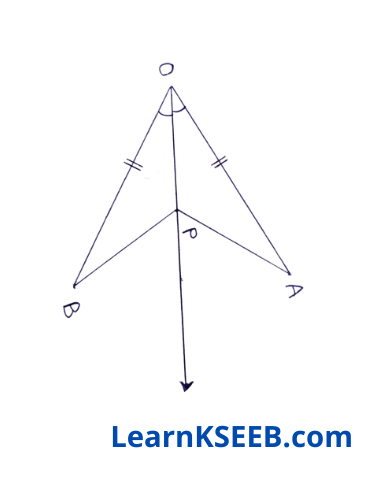
Solution: OA = OB (given)
OP = OP (common)
\(\lfloor\mathrm{AOP}\) = \(\lfloor\mathrm{BOP}\) (given)
∴ ΔOAP ≅ ΔOBP (bySAS)
Two Mark Questions
1. In the figure below, ABC is a Δle in which AB = AC, x & y are points on AB & AC. Such that AX = AY. Prove that ΔABY ≅ ΔACX

Solution: In ΔABY & ΔACX
AB=AC (given)
AY=AX (given)
\(\lfloor A\) = \(\lfloor A\) (common)
ΔABY = ΔACX (by SAS rule)
2. In the figure below ABCD A is a square & P is the midpoint of AD. BP & CP are joined. Prove that \(\lfloor\mathrm{PCB}\) = \(\lfloor\mathrm{PBC}\)

Solution: In ΔPAB &ΔPDC
PA= PD
(P is the mid-point of AD)
AB = CD
\(\lfloor\mathrm{PAB}\) = \(\lfloor\mathrm{PDC}\)= 90°
ΔPAB ≅ ΔPDC (by RHS rule)
PB = PC (C.P.C.T.)
=> \(\lfloor\mathrm{PCB}\) = \(\lfloor\mathrm{PBC}\)
3. In the figure below, the diagonal AC of quadrilateral ABCD, A bisects \(\lfloor\mathrm{BAD}\)& \(\lfloor\mathrm{BCD}\) .
Prove that BC = CD

Solution: In ΔADC & ΔABC
AC = AC (common)
\(\lfloor\mathrm{DAC}\) = \(\lfloor\mathrm{BAC}\) (given)
\(\lfloor\mathrm{DCA}\) = \(\lfloor\mathrm{BCA}\) (given)
Hence ΔADC ≅ ΔABC (by AAS rule)
=> CD = BC (byCPCT)
4. PS is an altitude of an isosceles Δle PQR in which PQ = PR. Show that PS bisects \(\lfloor P\)
Solution: In ΔPQS & ΔPRS
PQ = PR (given)
PS = PS (common)

\(\lfloor\mathrm{PSQ}\) = \(\lfloor\mathrm{PSR}\) = 90°
ΔPQS ≅ ΔPRS (byR.H.S. rule)
\(\lfloor\mathrm{QPS}\) = \(\lfloor\mathrm{RPS}\) (CPCT)
Hence, PS bisects \(\lfloor P\)
5. In the figure, given AC > AB & AD is the bisector of \(\lfloor A\). Show that \(\lfloor\mathrm{ADC}\) > \(\lfloor\mathrm{ADB}\)

Solution:
In ΔABC
AC>AB (given)
∴ \(\lfloor\mathrm{ABC}\) >\(\lfloor\mathrm{ACB}\) (angles opposite to larger side is greater)
\(\lfloor\mathrm{ABC}\) + \(\lfloor 1\) > \(\lfloor\mathrm{ACB}\) + \(\lfloor 1\) (adding \(\lfloor 1\) on both sides)
\(\lfloor\mathrm{ABC}\)+ \(\lfloor 1\) > \(\lfloor\mathrm{ACB}\) +\(\lfloor 2\) (AD bisects \(\lfloor A\),\(\lfloor 1\) =
\(\lfloor 2\))
∴ \(\lfloor\mathrm{ADC}\)>\(\lfloor\mathrm{ADB}\)
(Exterior angle property of Δle)
6. In figure, AD ⊥ CD & BC ⊥ CD & If AQ = BP & DP = CQ. Prove that
\(\lfloor\mathrm{DAQ}\) = \(\lfloor\mathrm{CBP}\)

Solution: DP = CQ
=> DP + PQ = CQ + PQ (adding PQ to both side)
=> DQ = CP
In right Δles ADQ&BCP
\(\lfloor\mathrm{ADQ}\) = \(\lfloor\mathrm{BCP}\) = 90°
Hyp. AQ = Hyp. BP (given)
side DQ = side CP
ΔADQ ≅ ΔBCP (by RHS rule)
∴ \(\lfloor\mathrm{DAQ}\)– \(\lfloor\mathrm{CBP}\) (C.P.C.T.)
7. Angles A, B & C of a triangle ABC are equal to each other, prove that ΔABC is equilateral Solution: \(\lfloor A\)= \(\lfloor B\)

=> BC = CA (sides opp. to equal angles of AABC) ………………(1)
\(\lfloor B\)=\(\lfloor C\)
=> CA=AB ……………(2) (sides opp. to equal angles of ΔABC)
\(\lfloor C\)= \(\lfloor A\)
=> AB = BC ………………(3) (sides opp. to equal angles of ΔABC)
from(l), (2) & (3) we get
AB = BC = CA
=> ΔABC is equilateral.
Three Mark Questions
1. In figure PQRS is a square & SRT is an equilateral triangle. Prove that
1) PT = QT
2) \(\lfloor\mathrm{TQR}\) =15°

Solution: 1) SRT is an equilateral Δle.
\(\lfloor\mathrm{PSR}\) = 90°, \(\lfloor\mathrm{TSR}\) – 60°
=> \(\lfloor\mathrm{PSR}\) + \(\lfloor\mathrm{TSR}\)=150°
||ly \(\lfloor\mathrm{QRT}\) = 150°
In ΔPST & ΔQRT
PS = QR
\(\lfloor\mathrm{PST}\) = \(\lfloor\mathrm{QRT}\) = 150°
ST = RT (sides of equilateral Δle)
ΔPST ≅ ΔQRT (by SAS rule)
=> PT=QT (byCPCT)
2) In ΔTQR
Square & equilateral Δle on same base)
=> \(\lfloor\mathrm{TQR}\) = \(\lfloor\mathrm{QTR}\) = x
∴ x + x+\(\lfloor\mathrm{QRT}\)= 180°
∴ 2x+150 = 180°
=> x=(180-150)/2
=> \(\lfloor\mathrm{TQR}\) = x =30/2=15°
2. In the figure, prove that CD+DA+AB+BC > 2AC.

Solution: In ΔABC
AB + BC > AC …………….(1) (as sum of two sides is greater than the 3rd side)
In ΔACD
CD + DA > AC …………….(2) (as sum of two sides is greater than the 3rd side)
adding (1) & (2), we get
CD + DA +AB + BC > 2AC
3. PQR is a Δle in which PQ = PR. S is any point on the side PQ, through S, a line is drawn parallel to QR intersecting PR at T. Prove that PS = PT.

Solution: PQ = PR
\(\lfloor\mathrm{PQR}\) = \(\lfloor\mathrm{PRQ}\)(angles opp. to p equal sides are equal)
ST || QR

=> \(\lfloor\mathrm{PST}\) = \(\lfloor\mathrm{PQR}\)(corresponding angles)
∴ \(\lfloor\mathrm{PTS}\) = \(\lfloor\mathrm{PRQ}\)(corresponding angles)
\(\lfloor\mathrm{PST}\) = \(\lfloor\mathrm{PTS}\)
=> PS = PT (sides opp. to equal angles are equal)
4. In the given figure, AD = BD, prove that BD < AC

Solution:
AD = BD
\(\lfloor\mathrm{ABD}\) = \(\lfloor\mathrm{DAB}\) = 59° (anglesopp. to equal sides are equal)
In ΔABD
59° + 59° + \(\lfloor\mathrm{ADB}\) = 180°
\(\lfloor\mathrm{ADB}\) = 180 – 118 = 62°
\(\lfloor\mathrm{ACD}\) = 62 – 32 = 30° (exterior angle is equal to the sum of interior opp. angles)
In ΔABD, AB > BD
(sides opp. to greater angle is the longest)
Also in ΔABC AB < AC
BD < AC
KSEEB Class 9 Maths Chapter 7 Triangles Exercises
5. In figure, OA = OD & \(\lfloor 1\) = \(\lfloor 2\) Prove that ΔOCBis an isosceles Δle.

Solution: \(\lfloor 1\) + \(\lfloor 3\) = 180° (linear pair)
\(\lfloor 2\)+ \(\lfloor 4\) = 180° (linear pair)
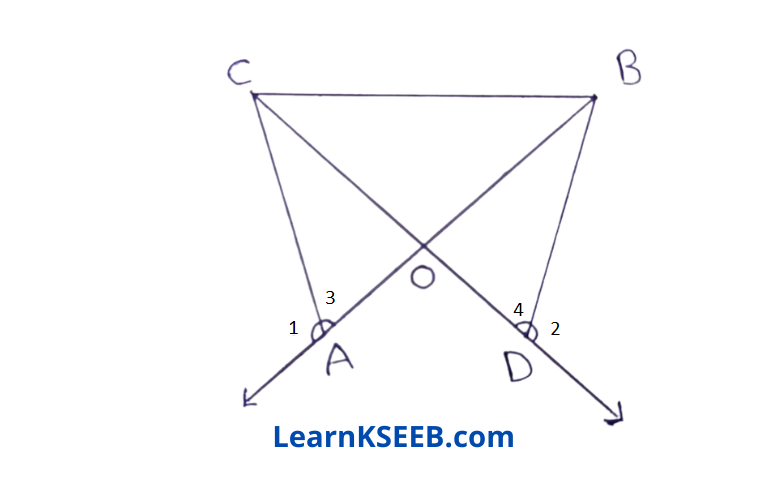
\(\lfloor 1\) + \(\lfloor 3\) = \(\lfloor 2\) + \(\lfloor 4\)
but \(\lfloor 1\) = \(\lfloor 2\) (given)
=> 12 = 14
In ΔDAC & ΔODB \(\lfloor 3\) = \(\lfloor 4\)
\(\lfloor\mathrm{AOC}\) = \(\lfloor\mathrm{DOB}\) (verticallyopp. angle)
OA = OD (given)
∴ ΔOAC ≅ ΔODB (by AS A rule)
OC = OB (C.P.C.T.)
=> ΔOCB is an isosceles triangle.
6. AD & BC are equal perpendiculars to a line segment AB
(1) show that CD bisects AB.
(2) What is its value?

Solution: AB & CD intersect at O
\(\lfloor\mathrm{AOB}\) = \(\lfloor\mathrm{BOC}\)
(vertically opp. angles)……..(1)
In ΔAOD & ΔBOC
\(\lfloor\mathrm{AOD}\) = \(\lfloor\mathrm{BOC}\) (V.O.A)
\(\lfloor\mathrm{DAO}\) = \(\lfloor\mathrm{CBO}\) = 90° (given)
AD = BC (given)
∴ ΔAOD ≅ ΔBOC (by AAS rule)
=> OA = OB
ie, O is the mid point of AB Hence CD bisects AB.
2) Equality is the sign of democracy.
7. l & m are two parallel equal lines intersected by another pair of parallel lines p & q. Show that ΔABC ≅ ΔCD A

Solution: l and m are two parallel equal lines intersected by another pair of parallel lines p & q.
AD || BC
& AB || CD
=> ABCD is a parallelogram
i.e.,AB = CD
& BC = AD
Now in ΔABC & ΔCDA
AB = CD
BC =AD
& AC = AC
∴ ΔABC ≅ ΔCDA (by SSS rule)
Four Mark Questions
1. If two parallel lines are intersected by a transversal then prove that bisectors of the interior angles form a rectangle
Solution: \(\lfloor\mathrm{AGH}\) = \(\lfloor\mathrm{HGD}\) (Alternate angle)

=> 1/2\(\lfloor\mathrm{AGH}\) = 1/2\(\lfloor\mathrm{GHD}\)
=> \(\lfloor 1\) =\(\lfloor 2\)
GM II LH
|| ly GL || MH
=> GMHL is a parallelogram
\(\lfloor\mathrm{BGH}\) + \(\lfloor\mathrm{GHD}\) = 180°
=> 1/2\(\lfloor\mathrm{BGH}\) + 1/2\(\lfloor\mathrm{GHD}\) = 90°
=> \(\lfloor 3\) + \(\lfloor 2\) = 90°
In ΔGLH
\(\lfloor\mathrm{GLH}\) = 180 — (\(\lfloor 2\)+ \(\lfloor 3\)) =180-90
\(\lfloor\mathrm{GLH}\) = 90°
=> \(\lfloor\mathrm{GMH}\) = 90°
So \(\lfloor\mathrm{MGL}\) + \(\lfloor\mathrm{GLH}\) = 180°
=>\(\lfloor\mathrm{MGL}\) +90°= 180°
=> \(\lfloor\mathrm{MGL}\) = 90°
∴ MGLH is a rectangle.
KSEEB Solutions Class 9 Triangles Practice Problems
2. In figure, the sides AB & AC of AABC are produced to points E&D respectively. If bisectors BO & CO of \(\lfloor\mathrm{CBE}\) & \(\lfloor\mathrm{BCD}\) respectively meet at a point O, then prove that
\(\lfloor\mathrm{BOC}\) = 90°-1/2\(\lfloor\mathrm{BAC}\)

Solution: As \(\lfloor\mathrm{ABC}\) & \(\lfloor\mathrm{CBE}\) form a linear pair.
\(\lfloor\mathrm{ABC}\) + \(\lfloor\mathrm{CBE}\) = 180°
BO is the bisector of \(\lfloor\mathrm{CBE}\)
 \(\lfloor\mathrm{CBE}\)= 2\(\lfloor 1\)\(\lfloor\mathrm{ABC}\)+ 2\(\lfloor 1\) = 180°
\(\lfloor\mathrm{CBE}\)= 2\(\lfloor 1\)\(\lfloor\mathrm{ABC}\)+ 2\(\lfloor 1\) = 180°
=> 2\(\lfloor 1\) = 180°-\(\lfloor\mathrm{ABC}\)
=> \(\lfloor 1\) = 90°-1/2\(\lfloor\mathrm{ABC}\) ……………..(1)
Again, \(\lfloor\mathrm{ACB}\)& \(\lfloor\mathrm{BCD}\) form a linear pair.
\(\lfloor\mathrm{ACB}\) + \(\lfloor\mathrm{BCD}\) = 180°
As CO if the bisector of \(\lfloor\mathrm{BCD}\)
\(\lfloor\mathrm{BCD}\) = 2\(\lfloor 2\)
\(\lfloor\mathrm{ACB}\) + 2\(\lfloor 2\) = 180°
2\(\lfloor 2\) = 180°-\(\lfloor\mathrm{ACB}\)
\(\lfloor 2\) = 90°-1/2\(\lfloor\mathrm{ACB}\) ……………(2)
In ΔOBC, we have
\(\lfloor 1\) + \(\lfloor 2\) + \(\lfloor\mathrm{BOC}\) = 180° …………….(3)
from (1), (2) & (3) we have
90- 1/2\(\lfloor\mathrm{ABC}\) + 90-1/2\(\lfloor\mathrm{ACB}\) + \(\lfloor\mathrm{BOC}\) = 180° ……………….(4)
Now in AABC we have \(\lfloor A\)+\(\lfloor B\) + \(\lfloor C\)=180°
\(\lfloor B\)+ \(\lfloor C\)=180°-\(\lfloor A\) …………………(5)
from equations (4) & (5), we have
180 – 1/2(180°-\(\lfloor A\)) + \(\lfloor\mathrm{BOC}\) = 180°
=> \(\lfloor\mathrm{BOC}\) = 180-180 +1/2(180-\(\lfloor A\))
\(\lfloor\mathrm{BOC}\) = 1/2(180-\(\lfloor A\))
=> \(\lfloor\mathrm{BOC}\)=90-1/2\(\lfloor A\)
3. In figure, ABCD is a square & EF is parallel to diagonal BD & EM = FM. Prove that
1) DF = BE
2) AM bisects \(\lfloor\mathrm{BAD}\)

Solution:

1) EF || BD
=> \(\lfloor 1\) = \(\lfloor 2\) [corresponding angles ]
\(\lfloor 3\) = \(\lfloor 4\)
but\(\lfloor 2\)= \(\lfloor 4\)
∴ \(\lfloor 3\) = \(\lfloor 1\)
=> FC = EC (sides opp. to equal angle)
CD – FC = CB – CE
=> DF = BE
AD =AB
\(\lfloor D\) = \(\lfloor B\) = 90°
∴ ΔADF = ΔABE(by SAS rule)
=> AF=AE (C.P.C.T.)
\(\lfloor 5\) = \(\lfloor 6\)
2) In ΔAMF & ΔAME
AF = AE
AM = AM (common)
FM = EM (given)
ΔAMF = ΔAME (by SSS rule)
∴ \(\lfloor 7\)= \(\lfloor 8\) (by CPCT)
\(\lfloor 7\) + \(\lfloor 5\) = \(\lfloor 8\)+ \(\lfloor 6\)
=> \(\lfloor\mathrm{MAD}\) = \(\lfloor\mathrm{MAB}\)
=> AM bisects \(\lfloor\mathrm{BAD}\)
4. Show that the difference of any two sides of a triangle is less than the third side.
Solution:
Construction: Take BD = AB, join AD
Proof: In ΔABD
AB = BD
=> \(\lfloor 1\) = \(\lfloor 3\) & \(\lfloor 4\)>\(\lfloor 1\)
=> \(\lfloor 4\) > \(\lfloor 3\)
In ΔADC
\(\lfloor 3\)>\(\lfloor 2\)

∴ \(\lfloor 4\)>\(\lfloor 3\)>\(\lfloor 2\)
=> \(\lfloor 4\)>\(\lfloor 2\)
=> AC > DC
=> AC > BC – BD (BC = BD + CD)
AC> BC – AB (BD = AB)
BC – AB < AC || ly, AC – AB < BC
& BC – AC < AB
5. In the figure, BL ⊥ AC, MC⊥LN, AL= CN & BL = CM, prove that ΔABC ≅ ΔNML

Solution: AL = CN (given)
AL + LC = CN + LC
ie AC = LN …………..(1)
In ΔALB & ΔNCM
AL = CN (given)
\(\lfloor\mathrm{ALB}\) = \(\lfloor\mathrm{NCM}\) = 90°
BL = CM (given)
∴ ΔALB & ΔNCM (by SAS rule)
=> AB=NM(CPCT) ……………(2)
In ΔBLC & ΔMCL
BL = MC (given)
\(\lfloor\mathrm{BLC}\)= \(\lfloor\mathrm{MCL}\) = 90°
LC = CL ……………(3)
∴ ΔBLC = ΔMCL (by SAS rule)
=> BC = ML(CPCT)
In ΔABC & ΔNML
AB=NM (proved in (1))
AC = NL (proved in (2))
BC = ML (proved in (3)
∴ ΔABC ≅ ΔNML (by SSS rule)

